PARADISO
When we speak about Boudja, we can not neglect Paradiso (today Şirinyer), which was a location quite integrated to the ‘Flower Village’ (as described by the author of this village, Niko Kararas1), Boudja.
Kararas mentions that 2 kms before Boudja, there was the railway station of Paradiso of the Izmir – Aydin line, and that in the old times it was the location of big trees and beautiful gardens which filled the human heart with joy and life. It was then called “the Paradise” where Cousinerys2 and Voutsinas3 had a lot of land and where towards 1907 beautiful villas were built.
Not very far from the station, there was the Hippodrome [archive photos]. Izmir is reputed to be the first in Turkey to organise horse races. Rauf Beyru, in his book “Life in Izmir in the XIX Century4” writes that towards 1840 races start without a specific organization and were the first in Turkey.
As indicated also in our site “Izmir and horse racing from yesterday to today - Sabri Yetkin - the first regular races with an established fixture started on 23 September 1856”.
We know again from Beyru, the visit of the Sultan Abdulaziz in 1863,
Oliver Jens Schimitt, also relate this event in his book “Les Levantins”5 emphasizing that in the tribunes there was all the high society of Smyrna, the Consul Count Bentivoglio, the members of the Jokey Club and the families Whittall, Hanson, Blackler, Blunt, Gout, Craith, Hadkinson, Crick, Hönischer, Wolff, Cooper, Lawson, Routh, Rose, Wood, Abbott, Barker, Joly, Lafontaine, Perkins, Van Lennep, Vedova, Cramer, Icard, Aliotti, Alberti, Carrer, Omiro, Amira, Costantinidi as well as the Consuls and the Marine officers of the “Powers”.
After the race the Orchestra of the Sultan played before that the Sultan proceeds to the villa of D. Baltazzi where a dinner was given. The numerous spectators of the race were kindly accommodated by the Boudja families, Blackler, Langdon, Hanson, Amira, Sevastopoulo, Fabrizzi, Carre, Cugino, Schiffmann, Ricci and the Catholic and Protestant priests.
There was a lot of interest for the races and therefore towards 1880 a second race was scheduled for the autumn. We know from the Hizmet Gazetesi [Newspaper] of 21/3/1891 that the spring race which was due to be performed in the 3rd day of Easter was changed due to the Ramazan and the newspaper was thanking Mr Purser of the Aydin Railways, an organizer of these races, for this kind gesture.
My friend Tayfur Göçmenoğlu, in his book “Beş On Sekiz Treni” (the Train of Five Eighteen) mentions that on 2nd of November 1950 a new Jokey Club was founded on the initiative of Nejat Evliyazade, the retired general Saim Onhon, Prince Halim Said Turkhan and Said Akson. One of the first members was William Giraud. Today in the Şirinyer (actual name of Paradiso) Hippodrome, the races are still successfully performed under the direction the Jockey Club, and there are even races in the late evening and the 4 restaurants there for the past 25 years have been the concession of the Karabilgins, my wife’s family. Furthermore in the vicinity there is the Buca Riding Club.
The International College (Popularly known as the American College, today the NATO Southeast Headquarters)
The college was firstly active as Smyrna International College that quickly progressed reaching 275 students and with the contribution of 25,000 USD in the year 1911, by Mrs John S. Kennedy, the International College was able to expand its facilities (The first president, MacLachlan - memoirs, archive photos) set within a sumptuous building with boarding facilities and a stadium, built at Paradiso in 1893 and remained active until 1936. My father, Constantine, before going to study at Aix Les Bains, France studied for a while at this College. The former prime minister Adnan Menderes also studied there. The building is now the Headquarters of the NATO Land Southeast.
Horses – Stables – Studs – Races – Riding
Tayfur Göçmenoğlu in his previously referred book mentions that in the 1950s, Fethi Simsaroğlu and William Giraud had studs at Boudja. The one belonging to Giraud was called Cennet Harasi – Paradiso Stud. These influenced a lot the progress of horsing in Boudja. I remember from the 60s the property of the Evliyazade’s close to the Boudja railway station with stables and horses as well as later on, the one at Gaziemir close to the present Izmir Airport. Furthermore in the old records, we see that Forbes6, Whittall, Paterson, Aliotti, Rees, Pirocaco, Balzoyani, were owners of racing horses. It is mentioned by Şerife Yorulmaz’s dissertation of “İzmir Basınında Levantenler, 19. yüzyılın ikinci yarısı” [References to Levantines in the press of Izmir during the second half of the 19th century] that a Paterson brought from England an English horse whose cost was thousand pounds and spent a high amount also for its stable (Ref: Ahenk Newspaper 4/4/1895). Amongst the horse owners, winners of the races of the same year in 1895, we have H. J. Whittall, V. Wilkinson, S. Rose, E. Charnaud, Paterson and Rees. Evliyazade Refik Bey [Municipal head of Izmir, period 1913-1918] in the years 1912 - 1922 contributed highly to amelioration of the races. In the attached races program of June 1915 from the book of Livio Missir – “Vie Latine de l’Empire Ottoman” we see as horse owners, Dr Lorando, De Portu, Kraemer, Aliotti, Mirzan, Pirocaco, Zanicopoulo, Chrissiou, Eyüp Sabri Bey and lieutenant Hasan Tahsin and Hüsnü Bey.
We learn from Mr de Jongh’s recollections that his grandfather Henry de Jongh (1862-1935) would compete in the races at Paradiso and the cap and blouse colours of the jockey were pink and grey.
In recent times, we saw the horses of the brothers Joe and Edwin Clarke, David Franco, Gür Özbelge (my classmate) in various races.
As far as I remember, William (Bill) Giraud, the Simsaroğlus, the Evliyazades and the Karamehmets won important races in the named “Gazi Koşusu”. The Giraud’s, the Koç’s, are good riders, winning many cups. In Istanbul, the Italo – Levantine Aldo Baldini was a famous rider.
In Istanbul which is home of Veliefendi one of the Historical Hippodromes, the interest for horses was always great. We see in the famous social club of Pera “Cercle d’Orient” (1882) many members were fan of horses and races (att image). In 1909 the Ottoman Jokey Club and in 1913 the Sipahi Ocağı were founded. In Kadıköy – Moda races are also performed and in 1920 with Ataturk, “the Gazi Kosusu” enters in the history at Ankara. In Macrıköy (today Bakırköy) at the iniative of the famous brigadier General Sir Loftus Bates a racing syndicate is created and a cement tribune is built at Veli Efendi Hypodrome. In 1923 races also existed at Büyükdere and Hugh Whittall in his writings “the Whittalls of Turkey 1809 – 1973” mentions that Polo was also played at Büyükdere.
Today the races at Veli Efendi are popular and on the 9 September 2007 race the Turkish horse Sabir beat the horse of H.M. the Queen Elisabeth (att. Hürriyet article).
Although I have not found a record on horse racing regarding my family in Turkey I remember that my mother used to recount with a lot of pride that my father used to ride along our Kasaba (now Turgutlu) farm on a horse without saddle.
Yorgo L. Zarifi in his memoirs stated that the reader could be surprized to learn that ladies used like to riding horses, even on an island as small that Prinkipo (the Prince Islands). Many gentlemen used to accompany Y. Zarifi’s mother in her ridings. Alexander Baltazzi from Vienna, Karatheodoris from Belgium and a very gentle Turkish officer Izzet Paşa.
I heard in more recent years that Mesude Evliyazade [wife of the former mayor] together with her close friend my aunt Geny Baltazzi Lipovatz (1904-1977) in their young age used to ride their horses in Boudja and were called by the locals “the Amazons”.
From an article in the 1950s Izmir Anglican Church magazine “Candlesticks”, we are informed that Paradiso was also the starting place for golf in Turkey - details.
Andrea Singros (Singrou), the Banker and the great benefactor of Greece, in his Memoirs7 mentions that the (Izmir, Boudja born) Baltazzi brothers Leonida (1829-1895) and Miltiades (1831-1898) were exporting Russian horses to the Egyptian Palace. It could be the same race horses mentioned as follow in the “Illustration” in 1864 with the attached image:
As it happened for hunting, the Levantines brought with them their passion for horses in the countries where they went after Turkey. We know that in Greece, the Rees had a concession for the Hippodrome of Athens, and in Egypt a Rees was a passionate gentleman rider, owner of a long time unbeated Arab horse. Marianne Barker (a family who moved from Smyrna to Alexandria, Egypt in the XIX Century) in her recollections mentions that “racing was Barker hobby and their racing box of the family was next to that of King Farouk. However with the revolution even the horses were confiscated”.
I know also that the Baltazzis of Athens were good riders and were frequenting the various riding clubs. I have been able in as far as my family is concerned to retrace this passion in various countries where they went after Turkey. I will briefly mention them:
In France: Jean Baltazzi (born in Izmir on 1795, died in Marseille on 1880) and Catherina Petrocochino’s (1820-1883) son’s George Baltazzi (1856-1920) born in Marseille, living and dying in Paris, received in 1908 from the French Minister of Agriculture, the honours of Chevalier (Knight) de La Legion d’Honneur “pour ses nombreux travaux et ecrits dans le presse hippique et pour les importants services a l’elevage (breed) avec 30 ans de pratique. Directeur Redacteur du Journal “Le Jockey” ainsi que President du Syndicat professionel de la Presse Hippique. Un prix Georges Baltazzi existe encore a nos jours a Maison Lafitte, Paris.”8
In the USA: My great grand father’s Demostene’s brother Xenofon (1833-1895) born Izmir (probably Boudja) died in New York City. An Ottoman Diplomat, First Secretary at the Ottoman Embassy in Washington, then Consul General at New York, marrying the American Emma Warner, they had a son Samuel Adams Warner Baltazzi (1877-1959?), Democrat Congress Candidate for NYC in 1920 – defeated by the Republican rival. Passionate about horses, he had a property at Aiken, S.C. described as follows on the internet:
In Austria: The summit of horse husbandry, is to be credited to the Izmir born but living and dying in Tarabya (Istanbul), the Banker Teodoro Baltazzi (1798-1860) and Elisa Sarell Baltazzi’s (1823-1863) Istanbul born sons in Vienna. Alexander (1850-1914), Hector (1851-1916), Aristides (1853-1914), Heinrich (1858-1929) who were founder members of the Jockey Club of Vienna, Aristide’s estate Napadejla in Moravia was a worldwide horse breeding farm. They had the best horses of Europe and Kisber, the Alexander’s horse, won in 1876 the Epsom Derby and the Grand Prix de Paris. Hector, had the reputation of the best reckless Gentleman Rider of Austria – Hungary. In the History of Horse Riding in the Czech Republic we read that in the famous Pardubicka Steeple – Chase, the first most successful rider happened to be Hector Baltazzi who managed to gain three victories. He had won in 1881 and 1883 in the saddle of a half-breed mare Victoria and in 1887 when riding ‘Woodman’.
In the racing calendar for the years 1873 and 1875 we see Alexander Baltazzi with a French grey body and scarlet cap and Hector Baltazzi with a light blue and black cap as well as Hector in the 1883 calendar, purple body with gold braid, scarlet sleeves and black velvet cap with gold fringe.
There is in the National Portrait Gallery of London, there is a portrait of Alexander Baltazzi by Joseph Brown after John Edwin Mayail.
In the perfect summer in England of 1911, just before the Storm of WWI, Juliet Nicolson mentions that people were stilL speaking of the summer when Mr Hector Baltazzi was so overcome by winning the Derby that he instructed his chief to float a pearl in every plate of watercress soup served at dinner that night.
It is said for Etti Plesch who earned a place in the Guinness Book of Records, as the only woman owner to have won the Derby twice (1961 and 1980) that her great knowledge of horses was inherited from her maternal grand father Aristides von Baltazzi. Etti Plesch (1914), who died in April 2003, was born Countess Maria Wurmbrand-Stuppach. Her mother May was daughter of Aristides von Baltazzi and Maria Theresia von Stockau. Etti by the age of 40, she had married 6 husbands and divorced 5 of them. The recent published book “Horses & Husbands (UK 2007, Hugo Vickers) contains her exciting memories.
Our fellow contributor and relative Mr Charles Sarell has an extraordinary documentation with pictures of this branch Baltazzi – Sarell in his recollections, in our site.
Alex Baltazzi, 2008

When we speak about Boudja, we can not neglect Paradiso (today Şirinyer), which was a location quite integrated to the ‘Flower Village’ (as described by the author of this village, Niko Kararas1), Boudja.
Kararas mentions that 2 kms before Boudja, there was the railway station of Paradiso of the Izmir – Aydin line, and that in the old times it was the location of big trees and beautiful gardens which filled the human heart with joy and life. It was then called “the Paradise” where Cousinerys2 and Voutsinas3 had a lot of land and where towards 1907 beautiful villas were built.
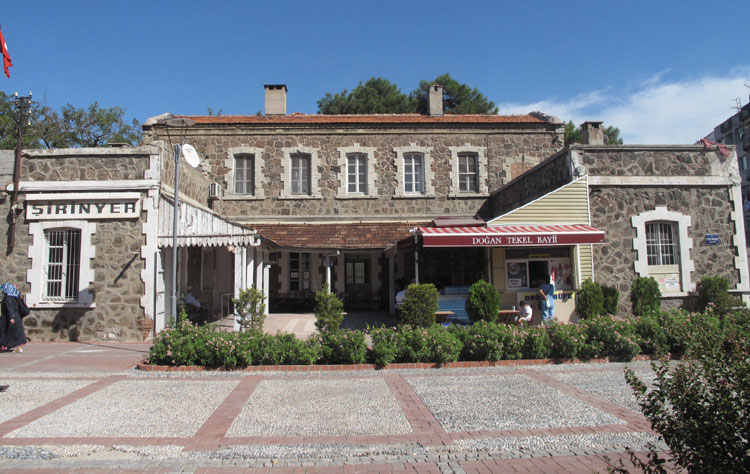 |
Paradiso / Şirinyer station today
Not very far from the station, there was the Hippodrome [archive photos]. Izmir is reputed to be the first in Turkey to organise horse races. Rauf Beyru, in his book “Life in Izmir in the XIX Century4” writes that towards 1840 races start without a specific organization and were the first in Turkey.
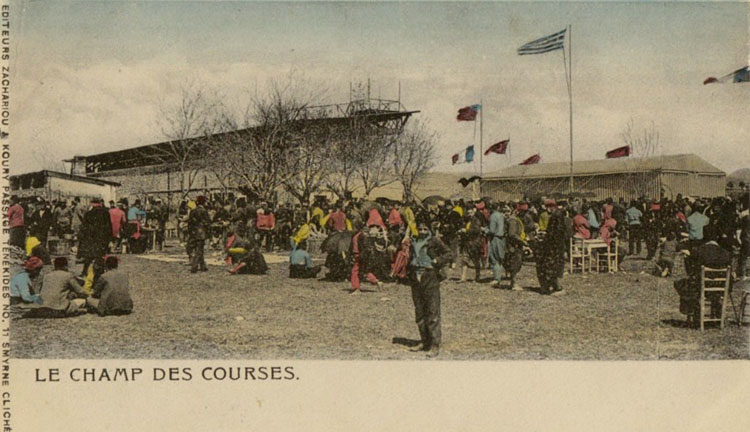 |
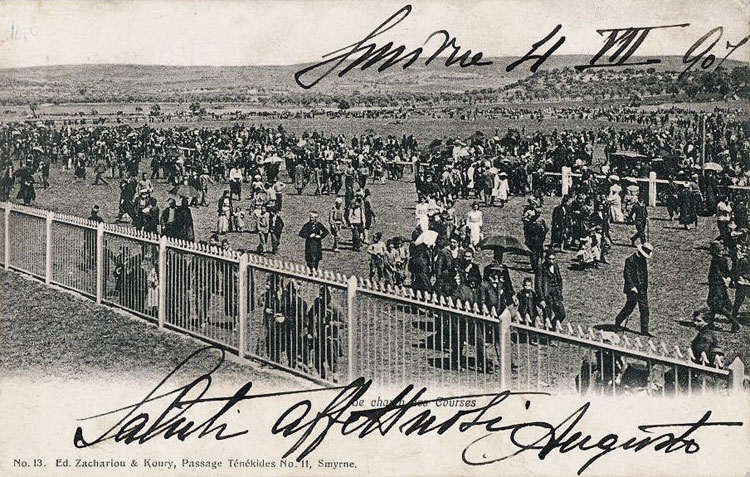 |
As indicated also in our site “Izmir and horse racing from yesterday to today - Sabri Yetkin - the first regular races with an established fixture started on 23 September 1856”.
We know again from Beyru, the visit of the Sultan Abdulaziz in 1863,
| “The Sultan on his way out of the Hisar Mosque, passing through the Turkish and Armenian quarters and then to the Caravan’s bridge, came under the Ionia’s shining sun to a place which satisfy all our expectations. Here is the Grand Paradise – Le Grand Paradis – Paradiso… The various riding performances at the Hippodrome have been watched with great attention and were very successful. A Whittall was a winner of a race. The honour mention went to the Chairman of the Jokey Club and Consul of France Count Bentivoglio d’Aragon who organized this event in the honour of this High Visitor. The Sultan invited the Count in his tent and gave him an Arabian Horse of his ecurie as gift. After the races, the Sultan went to Buca to relax at Baltazzi’s villa” |
Oliver Jens Schimitt, also relate this event in his book “Les Levantins”5 emphasizing that in the tribunes there was all the high society of Smyrna, the Consul Count Bentivoglio, the members of the Jokey Club and the families Whittall, Hanson, Blackler, Blunt, Gout, Craith, Hadkinson, Crick, Hönischer, Wolff, Cooper, Lawson, Routh, Rose, Wood, Abbott, Barker, Joly, Lafontaine, Perkins, Van Lennep, Vedova, Cramer, Icard, Aliotti, Alberti, Carrer, Omiro, Amira, Costantinidi as well as the Consuls and the Marine officers of the “Powers”.
After the race the Orchestra of the Sultan played before that the Sultan proceeds to the villa of D. Baltazzi where a dinner was given. The numerous spectators of the race were kindly accommodated by the Boudja families, Blackler, Langdon, Hanson, Amira, Sevastopoulo, Fabrizzi, Carre, Cugino, Schiffmann, Ricci and the Catholic and Protestant priests.
There was a lot of interest for the races and therefore towards 1880 a second race was scheduled for the autumn. We know from the Hizmet Gazetesi [Newspaper] of 21/3/1891 that the spring race which was due to be performed in the 3rd day of Easter was changed due to the Ramazan and the newspaper was thanking Mr Purser of the Aydin Railways, an organizer of these races, for this kind gesture.
My friend Tayfur Göçmenoğlu, in his book “Beş On Sekiz Treni” (the Train of Five Eighteen) mentions that on 2nd of November 1950 a new Jokey Club was founded on the initiative of Nejat Evliyazade, the retired general Saim Onhon, Prince Halim Said Turkhan and Said Akson. One of the first members was William Giraud. Today in the Şirinyer (actual name of Paradiso) Hippodrome, the races are still successfully performed under the direction the Jockey Club, and there are even races in the late evening and the 4 restaurants there for the past 25 years have been the concession of the Karabilgins, my wife’s family. Furthermore in the vicinity there is the Buca Riding Club.
The International College (Popularly known as the American College, today the NATO Southeast Headquarters)
The college was firstly active as Smyrna International College that quickly progressed reaching 275 students and with the contribution of 25,000 USD in the year 1911, by Mrs John S. Kennedy, the International College was able to expand its facilities (The first president, MacLachlan - memoirs, archive photos) set within a sumptuous building with boarding facilities and a stadium, built at Paradiso in 1893 and remained active until 1936. My father, Constantine, before going to study at Aix Les Bains, France studied for a while at this College. The former prime minister Adnan Menderes also studied there. The building is now the Headquarters of the NATO Land Southeast.
Horses – Stables – Studs – Races – Riding
Tayfur Göçmenoğlu in his previously referred book mentions that in the 1950s, Fethi Simsaroğlu and William Giraud had studs at Boudja. The one belonging to Giraud was called Cennet Harasi – Paradiso Stud. These influenced a lot the progress of horsing in Boudja. I remember from the 60s the property of the Evliyazade’s close to the Boudja railway station with stables and horses as well as later on, the one at Gaziemir close to the present Izmir Airport. Furthermore in the old records, we see that Forbes6, Whittall, Paterson, Aliotti, Rees, Pirocaco, Balzoyani, were owners of racing horses. It is mentioned by Şerife Yorulmaz’s dissertation of “İzmir Basınında Levantenler, 19. yüzyılın ikinci yarısı” [References to Levantines in the press of Izmir during the second half of the 19th century] that a Paterson brought from England an English horse whose cost was thousand pounds and spent a high amount also for its stable (Ref: Ahenk Newspaper 4/4/1895). Amongst the horse owners, winners of the races of the same year in 1895, we have H. J. Whittall, V. Wilkinson, S. Rose, E. Charnaud, Paterson and Rees. Evliyazade Refik Bey [Municipal head of Izmir, period 1913-1918] in the years 1912 - 1922 contributed highly to amelioration of the races. In the attached races program of June 1915 from the book of Livio Missir – “Vie Latine de l’Empire Ottoman” we see as horse owners, Dr Lorando, De Portu, Kraemer, Aliotti, Mirzan, Pirocaco, Zanicopoulo, Chrissiou, Eyüp Sabri Bey and lieutenant Hasan Tahsin and Hüsnü Bey.
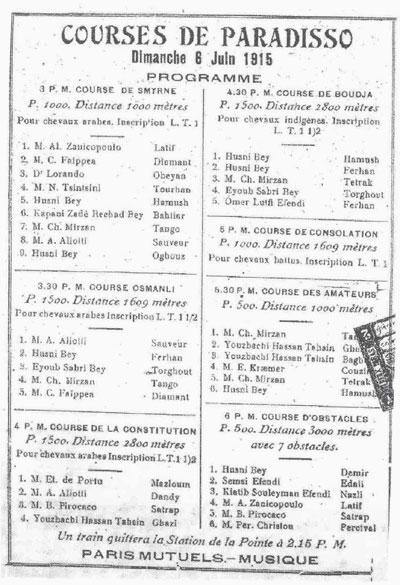 |
From the book of Livio Missir de Lusignan “Vie Latine de l’Empire Ottoman” (Editions Isis, Istanbul, 2004).
My Note: Regarding Lorando, I knew that they were Lorandos in Istanbul in the banking. However, as Karaca mentions, there were Lorandos also in Boudja. The one indicated in the announcement should be Dr Nicolau Lorando who had also a pharmacy in Boudja, and was relative to Dr Manicopoulo. He was certainly Greek and Orthodox. He could be however as Missir mentions of the same Latin origin of the Lorandos of Istanbul.
My Note: Regarding Lorando, I knew that they were Lorandos in Istanbul in the banking. However, as Karaca mentions, there were Lorandos also in Boudja. The one indicated in the announcement should be Dr Nicolau Lorando who had also a pharmacy in Boudja, and was relative to Dr Manicopoulo. He was certainly Greek and Orthodox. He could be however as Missir mentions of the same Latin origin of the Lorandos of Istanbul.
We learn from Mr de Jongh’s recollections that his grandfather Henry de Jongh (1862-1935) would compete in the races at Paradiso and the cap and blouse colours of the jockey were pink and grey.
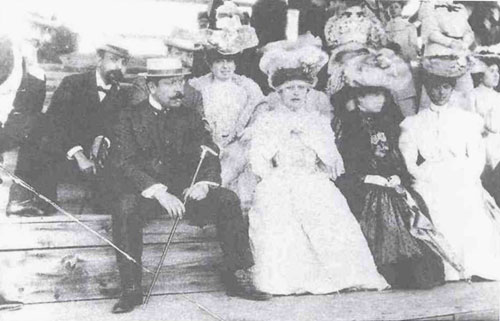 |
From the book “Races of Smirni (Before 1920)” (Fani N. Kleanthi Smirni Vivliopolio tis Estias Athens)
In recent times, we saw the horses of the brothers Joe and Edwin Clarke, David Franco, Gür Özbelge (my classmate) in various races.
As far as I remember, William (Bill) Giraud, the Simsaroğlus, the Evliyazades and the Karamehmets won important races in the named “Gazi Koşusu”. The Giraud’s, the Koç’s, are good riders, winning many cups. In Istanbul, the Italo – Levantine Aldo Baldini was a famous rider.
In Istanbul which is home of Veliefendi one of the Historical Hippodromes, the interest for horses was always great. We see in the famous social club of Pera “Cercle d’Orient” (1882) many members were fan of horses and races (att image). In 1909 the Ottoman Jokey Club and in 1913 the Sipahi Ocağı were founded. In Kadıköy – Moda races are also performed and in 1920 with Ataturk, “the Gazi Kosusu” enters in the history at Ankara. In Macrıköy (today Bakırköy) at the iniative of the famous brigadier General Sir Loftus Bates a racing syndicate is created and a cement tribune is built at Veli Efendi Hypodrome. In 1923 races also existed at Büyükdere and Hugh Whittall in his writings “the Whittalls of Turkey 1809 – 1973” mentions that Polo was also played at Büyükdere.
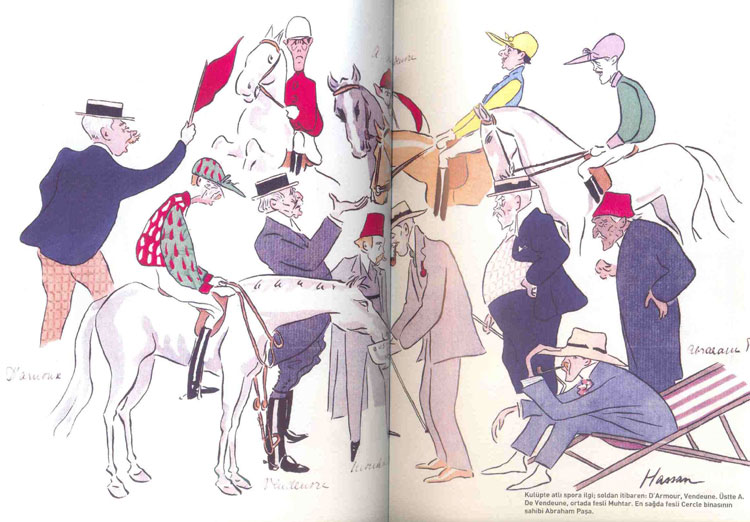 |
From the book “Cercle d’Orient’dan Büyük Kulüp’e” [From the Cercle d’Orient to the Big Club] (Orhan Kologlu, Boyut Kitapları, Istanbul, Mayıs 2005)
Names indicated on the cartoon, from the left: D’Armour, Vendeune, top: A. De Vendeune, extreme right with fez, the owner of the Cercle d’Orient building Abraham Pasha.
Names indicated on the cartoon, from the left: D’Armour, Vendeune, top: A. De Vendeune, extreme right with fez, the owner of the Cercle d’Orient building Abraham Pasha.
Today the races at Veli Efendi are popular and on the 9 September 2007 race the Turkish horse Sabir beat the horse of H.M. the Queen Elisabeth (att. Hürriyet article).
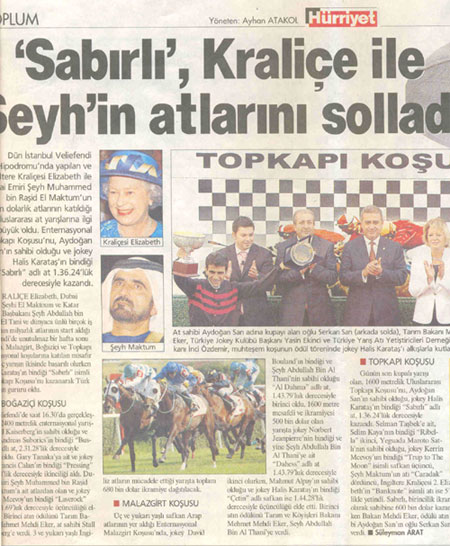 |
Although I have not found a record on horse racing regarding my family in Turkey I remember that my mother used to recount with a lot of pride that my father used to ride along our Kasaba (now Turgutlu) farm on a horse without saddle.
Yorgo L. Zarifi in his memoirs stated that the reader could be surprized to learn that ladies used like to riding horses, even on an island as small that Prinkipo (the Prince Islands). Many gentlemen used to accompany Y. Zarifi’s mother in her ridings. Alexander Baltazzi from Vienna, Karatheodoris from Belgium and a very gentle Turkish officer Izzet Paşa.
I heard in more recent years that Mesude Evliyazade [wife of the former mayor] together with her close friend my aunt Geny Baltazzi Lipovatz (1904-1977) in their young age used to ride their horses in Boudja and were called by the locals “the Amazons”.
From an article in the 1950s Izmir Anglican Church magazine “Candlesticks”, we are informed that Paradiso was also the starting place for golf in Turkey - details.
Andrea Singros (Singrou), the Banker and the great benefactor of Greece, in his Memoirs7 mentions that the (Izmir, Boudja born) Baltazzi brothers Leonida (1829-1895) and Miltiades (1831-1898) were exporting Russian horses to the Egyptian Palace. It could be the same race horses mentioned as follow in the “Illustration” in 1864 with the attached image:
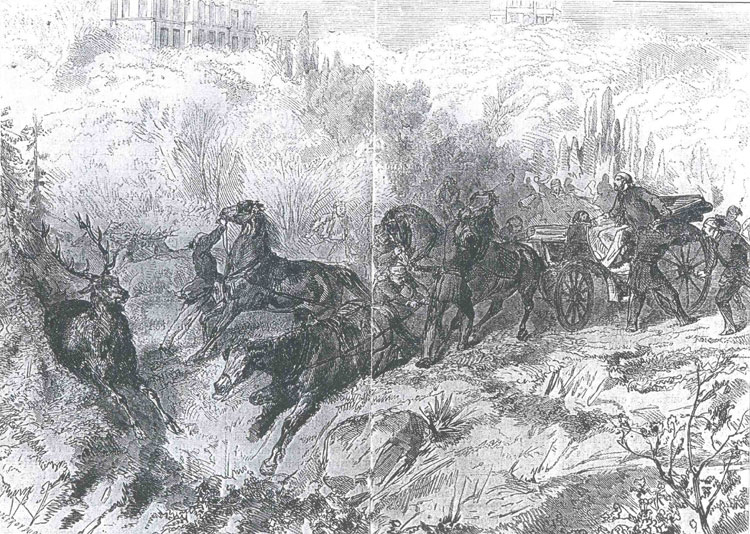 |
From the book “Eski İstanbul Arabalari” [Old Istanbul Cars] (Çelik Gülersoy, Türkiye Turing ve Otomobil Kurumu Yayını)
| “Last month the Sultan Abdulaziz having spent the afternoon at the Yildiz Kösk was returning to the Imperial Palace in his coach driven by four splendid Litvania horses gift of Mr Baltazzi. Suddenly male and female deers appeared in the front of the coach frighteening the horses and the coach risked to overturn. Fortunately with the help of the faithfull servants the danger was neutralized.” |
As it happened for hunting, the Levantines brought with them their passion for horses in the countries where they went after Turkey. We know that in Greece, the Rees had a concession for the Hippodrome of Athens, and in Egypt a Rees was a passionate gentleman rider, owner of a long time unbeated Arab horse. Marianne Barker (a family who moved from Smyrna to Alexandria, Egypt in the XIX Century) in her recollections mentions that “racing was Barker hobby and their racing box of the family was next to that of King Farouk. However with the revolution even the horses were confiscated”.
I know also that the Baltazzis of Athens were good riders and were frequenting the various riding clubs. I have been able in as far as my family is concerned to retrace this passion in various countries where they went after Turkey. I will briefly mention them:
In France: Jean Baltazzi (born in Izmir on 1795, died in Marseille on 1880) and Catherina Petrocochino’s (1820-1883) son’s George Baltazzi (1856-1920) born in Marseille, living and dying in Paris, received in 1908 from the French Minister of Agriculture, the honours of Chevalier (Knight) de La Legion d’Honneur “pour ses nombreux travaux et ecrits dans le presse hippique et pour les importants services a l’elevage (breed) avec 30 ans de pratique. Directeur Redacteur du Journal “Le Jockey” ainsi que President du Syndicat professionel de la Presse Hippique. Un prix Georges Baltazzi existe encore a nos jours a Maison Lafitte, Paris.”8
In the USA: My great grand father’s Demostene’s brother Xenofon (1833-1895) born Izmir (probably Boudja) died in New York City. An Ottoman Diplomat, First Secretary at the Ottoman Embassy in Washington, then Consul General at New York, marrying the American Emma Warner, they had a son Samuel Adams Warner Baltazzi (1877-1959?), Democrat Congress Candidate for NYC in 1920 – defeated by the Republican rival. Passionate about horses, he had a property at Aiken, S.C. described as follows on the internet:
| “Nandina (circa 1925) S. A. Warner Baltazzi was an Olympic Pistol Team Member and a great horseman. The grounds are lovely with formal gardens and a stone tea house at the end of the garden path. The adjoining structure was formerly the Baltazzi carriage house containing 16 stables. In 1962, it was converted to a private residence with a charming garden and pool.” |
In Austria: The summit of horse husbandry, is to be credited to the Izmir born but living and dying in Tarabya (Istanbul), the Banker Teodoro Baltazzi (1798-1860) and Elisa Sarell Baltazzi’s (1823-1863) Istanbul born sons in Vienna. Alexander (1850-1914), Hector (1851-1916), Aristides (1853-1914), Heinrich (1858-1929) who were founder members of the Jockey Club of Vienna, Aristide’s estate Napadejla in Moravia was a worldwide horse breeding farm. They had the best horses of Europe and Kisber, the Alexander’s horse, won in 1876 the Epsom Derby and the Grand Prix de Paris. Hector, had the reputation of the best reckless Gentleman Rider of Austria – Hungary. In the History of Horse Riding in the Czech Republic we read that in the famous Pardubicka Steeple – Chase, the first most successful rider happened to be Hector Baltazzi who managed to gain three victories. He had won in 1881 and 1883 in the saddle of a half-breed mare Victoria and in 1887 when riding ‘Woodman’.
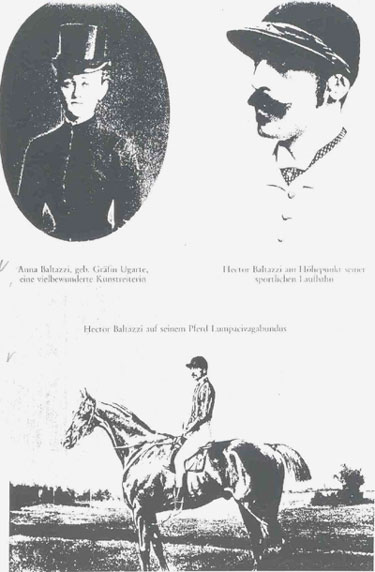 |
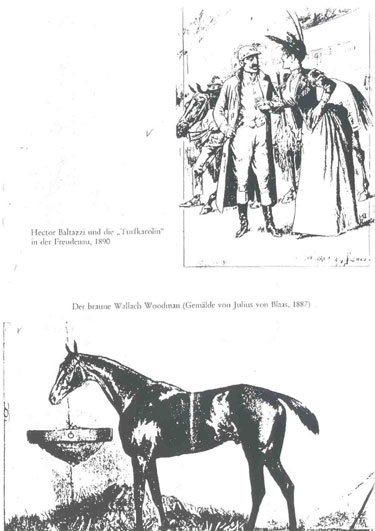 |
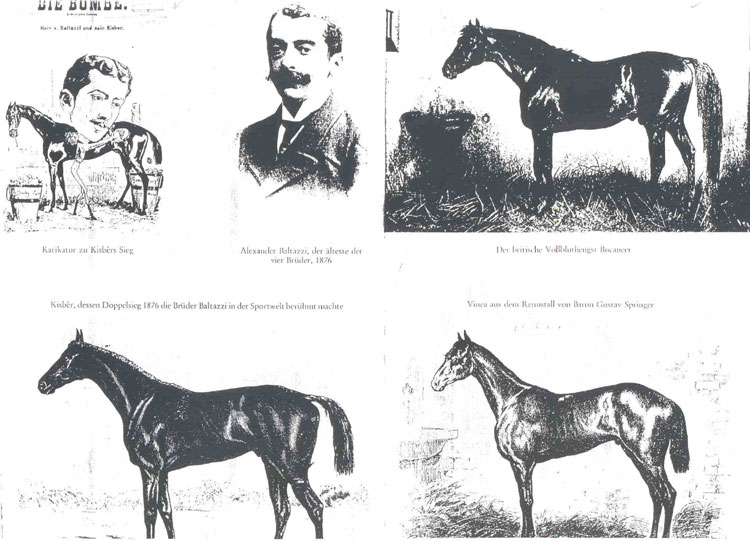 |
|
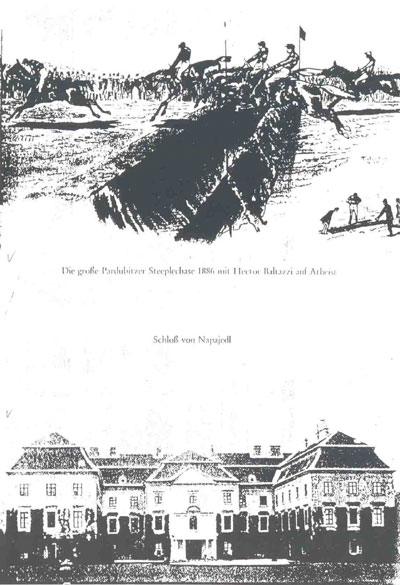 |
From the book of von Heinrich Baltazzi – Sharschmid and Hermann Swistun “Die Familien Baltazzi – Vetsera in Kaiserlichen Wien” (Hermann Böhlaus Nachf, Wien, Köln, Graz 1980)
In the racing calendar for the years 1873 and 1875 we see Alexander Baltazzi with a French grey body and scarlet cap and Hector Baltazzi with a light blue and black cap as well as Hector in the 1883 calendar, purple body with gold braid, scarlet sleeves and black velvet cap with gold fringe.
There is in the National Portrait Gallery of London, there is a portrait of Alexander Baltazzi by Joseph Brown after John Edwin Mayail.
In the perfect summer in England of 1911, just before the Storm of WWI, Juliet Nicolson mentions that people were stilL speaking of the summer when Mr Hector Baltazzi was so overcome by winning the Derby that he instructed his chief to float a pearl in every plate of watercress soup served at dinner that night.
It is said for Etti Plesch who earned a place in the Guinness Book of Records, as the only woman owner to have won the Derby twice (1961 and 1980) that her great knowledge of horses was inherited from her maternal grand father Aristides von Baltazzi. Etti Plesch (1914), who died in April 2003, was born Countess Maria Wurmbrand-Stuppach. Her mother May was daughter of Aristides von Baltazzi and Maria Theresia von Stockau. Etti by the age of 40, she had married 6 husbands and divorced 5 of them. The recent published book “Horses & Husbands (UK 2007, Hugo Vickers) contains her exciting memories.
Our fellow contributor and relative Mr Charles Sarell has an extraordinary documentation with pictures of this branch Baltazzi – Sarell in his recollections, in our site.
1 Nikos Kararas obituary (Bournabat 1893 – Athens 1975) (abstract from ‘Mikrasiatika Chronika’ 1975, pp 371-3)
He was born at the suburb of Bournovas (=Bournabat), Smyrna on December 1893. He finished the Greek Elementary school in 1906 and the Section of Commerce of Evangelliki Scholi in 1910. He continued studying at the American College of Paradiso, while obtaining professional experience by the great exporting companies of the East.
In 1919, during the Greek Occupation, he began his banking career at the National Bank of Greece. He served quite successfully, first at the Smyrna branch and then at the Athens headquarters, placed for eight years, until 1930, at the accounts’ office of the Commission for the Rehabilitation of Refugees (EAP). In fact, his career was brilliant until the end.
After his retirement he started another career, that of a writer. The first signs of it were revealed through his contributions to the literary magazines “Nea Zoi” (=New Life) and “Kosmos”: poems, translations, songs, and even an award-winning story in a Christmas contest.
In the “Prosfigikos Kosmos” (=Refugee World) Athens newspaper, there are many articles of his published (1956/7), among which descriptions and impressions from a visit to the Athos monasteries titled “Pilgrimage to the Holy Mountain”.
In the “Mikrasiatika Chronika” (=Asia Minor Chronicles) he published the stories of old Smyrnaean families such as the Bachatoris, Homeros and Pittakos.
His laborious historical and folklore research on the Smyrna villages gave within 15 years, from 1956 on, six books: “O Bournovas” (1955) (= Bournabat), First Prize of the “Estia Neas Smyrnis”, “Ta choria tou Bournova (1958) (=The Bournabat villages), “O Boudjas” (1958) “(1962) (=Boudjah), “To Sevdikioi” (1964), a Michalis Anastasiadis Award for “To Nymfaio” (1968), “To Kordelio” (1971), 1100 pages altogether, full of verified historical documents, traditions, ethics and customs, memories, his own personal experiences etc, a remarkable work that was honored by the Academy of Athens with a Praise for the contribution of Nikos Kararas in the preservation of the historical and folklore material of the region of Smyrna.
His last books were “Konstantinos Oikonomos o ex Oikonomon kai I Smyrni” (1971) and the translation of Willian Jouet “A journey to Kydonies, on May 1918” (post-mortem publication by the “Enosis Kydoniaton”, 1975)
Established among the litterateurs and historiographers of the Hellenism of the East, he worked with equal passion for the refugee affairs, cooperating with many refugee associations.
Particularly important was his fifteen-year old contribution to the cause and work of “Enosis Smyrnaion” (=Smyrnaean Association) were he worked as a member of the Editing Committee of “Mikrasiatika Chronika”, counselor, cashier, vice-president and president of the administrative board.
He dead on 19th of February 1975, suffering from a long-lasting illness.
- info courtesy of Achilleas Chatziconstantinou.
2 Cousinery: An important old Levantine Family from Izmir, originated from Marseilles, France. In the Indicateur Commercial 1898-1899, there is the following mention on page 180:
Marie Carmen Smyrnelis in her book for Izmir “Une Societe Hors de Soi” gives the Cousinery family as an example of professional endogamy (the practice of marrying within a social group) between the Levantine merchants of Izmir. The Cousinerys married with Salzani, Coutourier, Maltass, Moelhasen, Vanderzee and Lochner. 
3 a)According to Andrew Simes: My grandmother’s (Yvonne nee Balladur) great great great great grandmother was a Maria Vuccino. Her father was a Biaggio Vuccino. The Vuccino’s come from the island of Syros. However they were Hellenized and took the name Voutsinos.
A descendant from this family, Antonio Gregorio Vuccino was a well known archbishop for the Catholic community that existed on the island. A monument in memory of this great Archbishop can be found in the main square of the capital Galissas.
b) In the “History of the Island of Syra” in Greek of Timoleontos D. Ampela – printed in 1874 at Syros – reprinted in 1998, there is a mention of Vuccino’s amongst the Latins who came to the islands as from 1204 and later on.
1801: a Marco Vuccino, as “proestos” in charge of security and collection of taxes in the elected members of the municipality and in the commission regarding to the tax to be paid to the Sultana (Ottoman Queen Mother).
1821: Marco Vuccino member of the Latin community.
1835 – 1837 > K. Vuccino in the mayorship assembly of Syra
1850 – 53 – 58: A. Vuccinas member of the mayerhip assembly of Ermoupolis (Syra).
c) The Vuccino name is also visible in the baptismal registers of Chios, here:
d) In the book “Levantins” of Oliver Jens Scmitt, for Vuccinos in Istanbul.
1750: Vuccino’s are mentioned amongst the Levantine families of Galata – Pera.
Vuccino mentioned in the Catholic insular families of XIX and beginning XX centuries.
From Naxos and Samos: Vuccino
From Tinos: Vuccino
Vuccino: Carpenter
1831: in a religious act: Natale Vuccino (Reya – Latin)
1833: Ziver Bey Han (Hans of Galata – Pera)
P. Vuccino – commissionaire
1839: Petition to the Pope of the Latin Nation
L. Vuccino, M. Vuccino betwen those who signed the Petition
1856 – 1872: Amongst the French protected – Vuccino
1869 – 1870: In the lawsuits of the Italian Consulate Don Gasparo Vuccino
Nicolas Vuccino: A Catholic of the Islands – Austrian nationality but French protected as representative of the French navigation – Frassinet.
End of WWI: Lawyer Vuccino on the defense of Italian citizens interests.
Towards 1910-12: In the conference of St Esprit, E.Vuccino active member.
e) The family were also involved in the production of silk, Vuccino (mention at the London Exposition of 1862), the book: From Tanzimat Dönemi Sanayi [Industry in the Reform period] – Prof. Dr Rifat Önsöz.
f) A recently published article of Doçent Y. Işil Ülman at the prestige volume of the Company Ferroli, issued recently in Istanbul “Presenze Italiene ad Istanbul” complicates the situation as the author has difficulties in placing the Vuccinos in one family - section.
g) Information and the photo of Fokion Voutsinas (born in 1855 at Syra) of Boudja (Greek – Orthodox), features in the Boudja book of Karara - view.
In my opinion it looks like a Latin (probably Italian) family based in Syra & islands origin could be foreseen, and as our contributor Simes notes, subject to Hellenization with Orthodox faith as exampled by the Fokion Voutsinas family of Boudja. But for the various other Vuccinos in Istanbul, it looks difficult to integrate them in one sole family. Relatives and researchers could enlight us better.
4 19. Yüzyılda İzmir’de Yaşam [Life in Izmir in the 19th Century], Yayıncılık Dağıtım, Pazarlama Sanayi ve Ticaret Ltd Şti., 2000
5 Oliver Jens Schimitt, Levantins, French Trans. from the original German by J. F. de Andria, Ed. Isis, Istanbul, 2007.
6 Evidence of [David?] Forbes’s involvement in horse racing and his use of his contacts in Aleppo and region to obtain the best Arabian horses are viewable in this archive book: My quest of the Arabian Horse.
Evidence on horsing history web sites points to an even earlier quest by the British for Arabian thoroughbreds, and this raises the possibility of the Levantine involvement in horses, for pleasure and trade rather than racing, back to the early 18th century?
7 Memoirs: Andrea Singros (Singrou) Apomnimonemata – Tomes A and B – Study of Alkis Agelou Maria Christina Hadjiyani - Bibliopolio Tis Estias 1998 – Athens.
8 For his several works and writings in the riding press and for his important services for the breed with 30 years practice. Director – Editor of the newspaper “Le Jockey” and President of the Professional Syndicate of the Riding Press. A race, Georges Baltazzi, still exists on our days at Maisson Lafitte, Paris.
Click here to view an archive photo of some Levantines enjoying a picnic at the Kızılçullu end of Paradise [little Paradise] and here for some more archive views of that area.
Click here for Mr Baltazzi’s earlier article on the heritage of the neighbouring village of Boudja.
Click here for Mr Baltazzi’s companion article on the heritage of Cordelio / Karşıyaka.
Click here for Mr Baltazzi’s companion article on the heritage of Bournabat / Bornova.
Click here for Mr Baltazzi’s companion article on the heritage of Bayraklı / Turan and region.
He was born at the suburb of Bournovas (=Bournabat), Smyrna on December 1893. He finished the Greek Elementary school in 1906 and the Section of Commerce of Evangelliki Scholi in 1910. He continued studying at the American College of Paradiso, while obtaining professional experience by the great exporting companies of the East.
In 1919, during the Greek Occupation, he began his banking career at the National Bank of Greece. He served quite successfully, first at the Smyrna branch and then at the Athens headquarters, placed for eight years, until 1930, at the accounts’ office of the Commission for the Rehabilitation of Refugees (EAP). In fact, his career was brilliant until the end.
After his retirement he started another career, that of a writer. The first signs of it were revealed through his contributions to the literary magazines “Nea Zoi” (=New Life) and “Kosmos”: poems, translations, songs, and even an award-winning story in a Christmas contest.
In the “Prosfigikos Kosmos” (=Refugee World) Athens newspaper, there are many articles of his published (1956/7), among which descriptions and impressions from a visit to the Athos monasteries titled “Pilgrimage to the Holy Mountain”.
In the “Mikrasiatika Chronika” (=Asia Minor Chronicles) he published the stories of old Smyrnaean families such as the Bachatoris, Homeros and Pittakos.
His laborious historical and folklore research on the Smyrna villages gave within 15 years, from 1956 on, six books: “O Bournovas” (1955) (= Bournabat), First Prize of the “Estia Neas Smyrnis”, “Ta choria tou Bournova (1958) (=The Bournabat villages), “O Boudjas” (1958) “(1962) (=Boudjah), “To Sevdikioi” (1964), a Michalis Anastasiadis Award for “To Nymfaio” (1968), “To Kordelio” (1971), 1100 pages altogether, full of verified historical documents, traditions, ethics and customs, memories, his own personal experiences etc, a remarkable work that was honored by the Academy of Athens with a Praise for the contribution of Nikos Kararas in the preservation of the historical and folklore material of the region of Smyrna.
His last books were “Konstantinos Oikonomos o ex Oikonomon kai I Smyrni” (1971) and the translation of Willian Jouet “A journey to Kydonies, on May 1918” (post-mortem publication by the “Enosis Kydoniaton”, 1975)
Established among the litterateurs and historiographers of the Hellenism of the East, he worked with equal passion for the refugee affairs, cooperating with many refugee associations.
Particularly important was his fifteen-year old contribution to the cause and work of “Enosis Smyrnaion” (=Smyrnaean Association) were he worked as a member of the Editing Committee of “Mikrasiatika Chronika”, counselor, cashier, vice-president and president of the administrative board.
He dead on 19th of February 1975, suffering from a long-lasting illness.
- info courtesy of Achilleas Chatziconstantinou.
2 Cousinery: An important old Levantine Family from Izmir, originated from Marseilles, France. In the Indicateur Commercial 1898-1899, there is the following mention on page 180:
Cousinery et fils, maison fondée en 1830 – exportation produits du pays en general. Moulin a vapeur pour farine (a Daragatch) fabrique de coton, rue dit Ancien Jardin, et agents d’assurance, collaborateurs de la maison Albert Balian et Gaston Champsaur. Local Cousinery, Izmir. |
3 a)According to Andrew Simes: My grandmother’s (Yvonne nee Balladur) great great great great grandmother was a Maria Vuccino. Her father was a Biaggio Vuccino. The Vuccino’s come from the island of Syros. However they were Hellenized and took the name Voutsinos.
A descendant from this family, Antonio Gregorio Vuccino was a well known archbishop for the Catholic community that existed on the island. A monument in memory of this great Archbishop can be found in the main square of the capital Galissas.
b) In the “History of the Island of Syra” in Greek of Timoleontos D. Ampela – printed in 1874 at Syros – reprinted in 1998, there is a mention of Vuccino’s amongst the Latins who came to the islands as from 1204 and later on.
1801: a Marco Vuccino, as “proestos” in charge of security and collection of taxes in the elected members of the municipality and in the commission regarding to the tax to be paid to the Sultana (Ottoman Queen Mother).
1821: Marco Vuccino member of the Latin community.
1835 – 1837 > K. Vuccino in the mayorship assembly of Syra
1850 – 53 – 58: A. Vuccinas member of the mayerhip assembly of Ermoupolis (Syra).
c) The Vuccino name is also visible in the baptismal registers of Chios, here:
d) In the book “Levantins” of Oliver Jens Scmitt, for Vuccinos in Istanbul.
1750: Vuccino’s are mentioned amongst the Levantine families of Galata – Pera.
Vuccino mentioned in the Catholic insular families of XIX and beginning XX centuries.
From Naxos and Samos: Vuccino
From Tinos: Vuccino
Vuccino: Carpenter
1831: in a religious act: Natale Vuccino (Reya – Latin)
1833: Ziver Bey Han (Hans of Galata – Pera)
P. Vuccino – commissionaire
1839: Petition to the Pope of the Latin Nation
L. Vuccino, M. Vuccino betwen those who signed the Petition
1856 – 1872: Amongst the French protected – Vuccino
1869 – 1870: In the lawsuits of the Italian Consulate Don Gasparo Vuccino
Nicolas Vuccino: A Catholic of the Islands – Austrian nationality but French protected as representative of the French navigation – Frassinet.
End of WWI: Lawyer Vuccino on the defense of Italian citizens interests.
Towards 1910-12: In the conference of St Esprit, E.Vuccino active member.
e) The family were also involved in the production of silk, Vuccino (mention at the London Exposition of 1862), the book: From Tanzimat Dönemi Sanayi [Industry in the Reform period] – Prof. Dr Rifat Önsöz.
f) A recently published article of Doçent Y. Işil Ülman at the prestige volume of the Company Ferroli, issued recently in Istanbul “Presenze Italiene ad Istanbul” complicates the situation as the author has difficulties in placing the Vuccinos in one family - section.
g) Information and the photo of Fokion Voutsinas (born in 1855 at Syra) of Boudja (Greek – Orthodox), features in the Boudja book of Karara - view.
In my opinion it looks like a Latin (probably Italian) family based in Syra & islands origin could be foreseen, and as our contributor Simes notes, subject to Hellenization with Orthodox faith as exampled by the Fokion Voutsinas family of Boudja. But for the various other Vuccinos in Istanbul, it looks difficult to integrate them in one sole family. Relatives and researchers could enlight us better.
4 19. Yüzyılda İzmir’de Yaşam [Life in Izmir in the 19th Century], Yayıncılık Dağıtım, Pazarlama Sanayi ve Ticaret Ltd Şti., 2000
5 Oliver Jens Schimitt, Levantins, French Trans. from the original German by J. F. de Andria, Ed. Isis, Istanbul, 2007.
6 Evidence of [David?] Forbes’s involvement in horse racing and his use of his contacts in Aleppo and region to obtain the best Arabian horses are viewable in this archive book: My quest of the Arabian Horse.
Evidence on horsing history web sites points to an even earlier quest by the British for Arabian thoroughbreds, and this raises the possibility of the Levantine involvement in horses, for pleasure and trade rather than racing, back to the early 18th century?
7 Memoirs: Andrea Singros (Singrou) Apomnimonemata – Tomes A and B – Study of Alkis Agelou Maria Christina Hadjiyani - Bibliopolio Tis Estias 1998 – Athens.
8 For his several works and writings in the riding press and for his important services for the breed with 30 years practice. Director – Editor of the newspaper “Le Jockey” and President of the Professional Syndicate of the Riding Press. A race, Georges Baltazzi, still exists on our days at Maisson Lafitte, Paris.
Click here to view an archive photo of some Levantines enjoying a picnic at the Kızılçullu end of Paradise [little Paradise] and here for some more archive views of that area.
Click here for Mr Baltazzi’s earlier article on the heritage of the neighbouring village of Boudja.
Click here for Mr Baltazzi’s companion article on the heritage of Cordelio / Karşıyaka.
Click here for Mr Baltazzi’s companion article on the heritage of Bournabat / Bornova.
Click here for Mr Baltazzi’s companion article on the heritage of Bayraklı / Turan and region.
Alex Baltazzi, 2008